Letters and Literature
Women and letters feature prominently in Dutch genre paintings from the second half of the seventeenth century. Captivating images show women reading, writing, and receiving letters, often in the company of books, and exchanging ideas with present or absent companions. Although the contents of these missives are rarely legible, they invite curiosity and contemplation, drawing the beholder into intimate, domestic spaces. Such scenes emphasize women’s engagement with the written word and demonstrate a remarkable interest in representing their intellectual lives.
The popularity of epistolary themes in Dutch genre painting reflected a rise in the use of personal correspondence—particularly in the exchange of love letters—among the Dutch upper classes in this period, as well as advances in the postal system and the publication of letter-writing manuals
In seventeenth-century Dutch society, letter reading and writing held profound significance, especially for women. Letters allowed women to cultivate personal expression and maintain connections across distances, granting them a voice and influence in a world where their roles were otherwise limited. For many Dutch women, letters provided a way to manage social, economic, and emotional bonds—acting as a substitute for physical presence and often a medium for discussing matters of business, family, or affection.
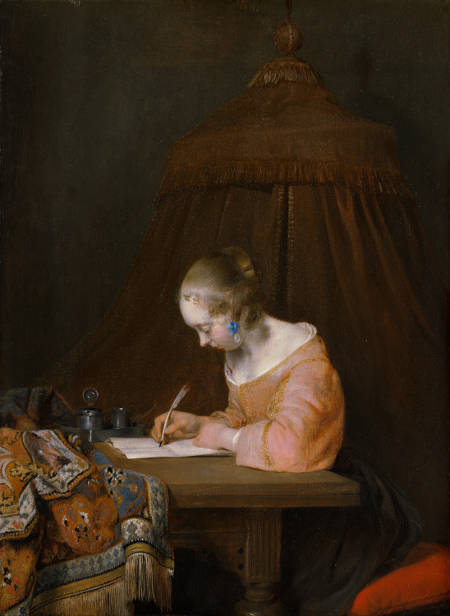
Gerrit ter Borch
?
Oil on panel. 38.3 x 27.9 cm.
Mauritshuis, The Hague
Letters enabled women to transcend the limitations placed upon their gender, at least in a personal or literary sense. Writing provided them with the means to reflect upon and subtly shape their social realities. For married women or those in high-status households, letters allowed them to manage estate affairs or even exercise influence over economic matters when male family members were away, such as during merchant expeditions. For unmarried or cloistered women, letter writing offered a socially acceptable outlet for their voices, helping maintain kinship ties, personal relationships, or devotional connections (fig. 1).
While declarations of love in letters were not strictly legal documents, they had the potential to carry legal implications, particularly when they intersected with matters of marriage, reputation, or financial promises. Courts might consider them as circumstantial evidence rather than as primary legal documents, especially in cases of breached engagements or disputed promises. In this sense, love letters played a role not only as expressions of personal affection but also as artifacts that could support claims or defend reputations, adding a layer of legal weight to their social significance.
Love Letters in the Seventeenth-Century Netherlands
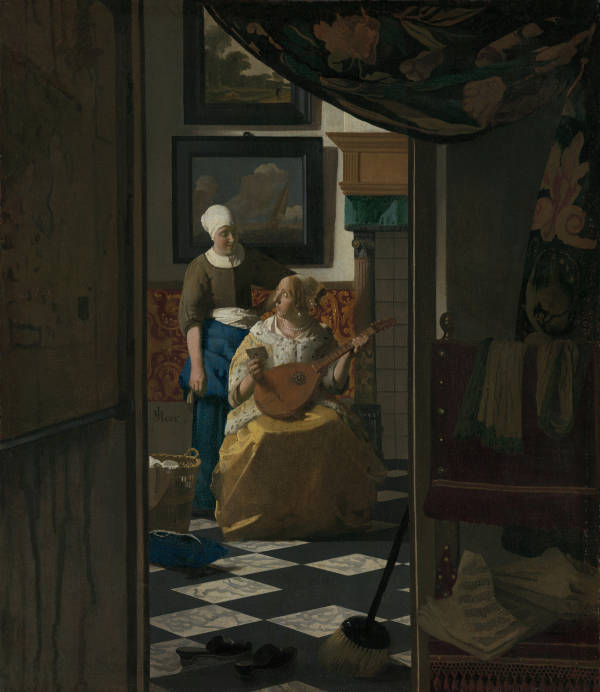
Johannes Vermeer
c. 1667–1670
Oil on canvas
44 x 38.5 cm.
Rijksmuseum, Amsterdam
Love letters in the seventeenth-century Netherlands provide a compelling view into the personal and social dynamics of the period (fig. 2). These letters offer not only insights into romantic relationships but also reveal much about social conventions, literary styles, and individual expression. In a period marked by significant religious, economic, and cultural changes, love letters served as important vehicles for private communication, reflecting both personal feelings and broader societal expectations.
During the Dutch Golden Age, the practice of writing love letters was intertwined with the norms of courtship and marriage. It was an era when marriage was often a carefully negotiated matter involving families and social networks, yet private expressions of affection played a key role in bonding couples. For many, love letters were one of the few avenues for direct and unmediated communication between romantic partners, providing them with a space to articulate their feelings. Such letters ranged from cautious, formal expressions of interest to passionate declarations of love, with the tone and style shaped by the sender’s background and the relationship’s context.
The language of these letters was often crafted to reflect both affection and respect, adhering to social decorum while allowing space for tender sentiments. The content of these letters often included references to contemporary literature, religious themes, and moral undertones, which reflected the deeply ingrained values of the time. Biblical allusions and references to well-known poets were common, as these conveyed a sense of earnestness and propriety. The letters thus served a dual function: they expressed personal emotion while reinforcing moral and ethical standards.
Materially, letters in the seventeenth century were written on paper that varied in quality depending on the writer's socioeconomic status, and they were typically folded and sealed with wax for privacy. The delivery of letters was a delicate matter, as postal services were limited, and letters often relied on trusted intermediaries or were handed over in person. The process of exchanging letters could therefore be fraught with anticipation and secrecy, adding another layer of meaning to the written words.
The art of letter writing itself was influenced by the Renaissance humanist tradition, which emphasized eloquence and self-reflection. This literary tradition encouraged writers to engage in introspection and articulate their feelings with clarity and depth, skills highly valued in educated circles. For women, who had fewer opportunities for public expression, love letters were one of the rare platforms where they could express their thoughts and emotions directly, though often within the confines of prescribed decorum.
In addition to romantic intent, these letters could carry undertones of duty and moral obligation, reflective of the era’s values around commitment and social roles. Marital alliances were seen as both personal and societal commitments, so letters between betrothed individuals frequently touched on themes of loyalty, fidelity, and mutual support.
Letter-Writing Manuals
Letter-writing manuals in the seventeenth-century Netherlands were instrumental in educating individuals on the conventions of epistolary communication, particularly regarding love and courtship. These guides standardized formats and language, offering templates and examples for expressing personal sentiments within socially acceptable boundaries. The popularity of epistolary themes in Dutch genre painting reflected a rise in the use of personal correspondence—particularly in the exchange of love letters—among the Dutch upper classes in this period, as well as advances in the postal system and the publication of letter-writing manuals.
One notable manual was "Den Nederlandtschen Secretaris" by Abraham de Rijcke, which provided a comprehensive collection of sample letters for various occasions, including romantic correspondence. Another significant figure was Jacob Cats, a renowned poet and moralist whose works, such as "Houwelick" ("Marriage"), included discussions on love and offered moral guidance. Although not strictly letter-writing manuals, Cats's writings were influential in shaping societal views on love and relationships.
The diffusion of these manuals was facilitated by the thriving Dutch printing industry, making them accessible to a broader segment of the population. This widespread availability contributed to a more uniform practice of letter writing across different social classes, enabling individuals to navigate the complexities of romantic communication with greater confidence and adherence to social norms.
The Visual Arts
In the visual arts, women, both as subjects and creators, made significant contributions. Portraits of nuns and religious women presented unique challenges, balancing the need for likeness without compromising religious decorum and clausura (the monastic practice of enclosure). Artists had to navigate the representation of individual identity while adhering to monastic ideals of modesty and community.
Older women, often overlooked in art historical discourse, were depicted with wrinkles, warts, and other markers of aging. These images challenged contemporary ideals of female beauty and provided a more nuanced understanding of women's experiences with aging. The careful rendering of elderly women in art highlights the cultural significance of all stages of women’s lives during this period.
Prior to the seventeenth century, European art seldom featured contemporary, ordinary women, especially those who were neither wealthy nor famous. The Dutch Golden Age saw a transformation in this regard, with artists frequently portraying housewives engaged in everyday tasks such as cooking, sewing, and cleaning. These paintings, often rendered on small canvases with muted colors, presented women in plain attire, emphasizing the simplicity and dignity of their domestic responsibilities.
Some scholars interpret these domestic scenes as evidence of women’s second-class status, suggesting that they were confined to the household by patriarchal norms. However, an alternative perspective recognizes these works as expressions of respect and appreciation for the essential contributions women made to society. The prominence of ordinary women in art signified a recognition of their roles in maintaining the moral and social fabric of the Dutch Republic.
Gesina ter Borch
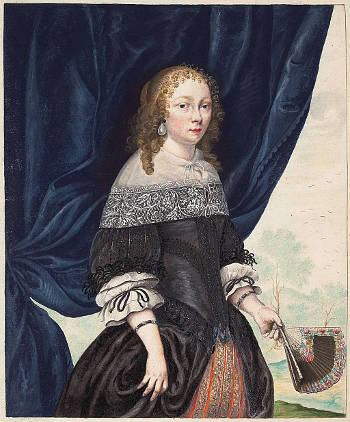
Gesina ter Borch
1661
Paint-brush in black and colours, costume albumen washed, under-dress heightened with gold and silver on paper, 24.3 x 36 cm.e
Recent scholarship has highlighted the significance of Gesina ter Borch (1631–1690) (fig. 4), an often-overlooked figure in the artistic landscape of the seventeenth-century Dutch Republic. Nicole E. Cook,Nicole E. Cook, "The Art of Domestic Life: Family Albums in the Dutch Golden Age" (Ph.D. diss., University of California, Berkeley, 2013). an art historian specializing in early modern arts and object-based study, has made substantial contributions to reshaping Gesina ter Borch's place in Dutch art history. Cook’s research challenges the conventional categorization of Gesina as merely an "amateur" artist, arguing instead for a more nuanced appreciation of her work and its impact. The following discussion draws on Cook's insights into Gesina ter Borch’s artistic achievements and her unique contributions to the visual culture of the Dutch Golden Age.
Despite being traditionally labeled as an "amateur" due to her lack of formal apprenticeship, absence from the public art market, and non-membership in an artist guild, Gesina’s body of work demonstrates a deep commitment to artistic practice. This categorization, rooted in gendered biases, has long hindered an accurate assessment of her accomplishments. A reevaluation of Gesina’s career reveals her to be a serious artist who, although operating outside the conventional structures of the art market, made notable contributions to Dutch art, particularly through her illustrated albums and her engagement with both visual and literary forms.
Born in 1631 to Gerrit ter Borch the Elder, himself an artist, Gesina was part of a highly creative family. Unlike her brother Gerrit ter Borch the Younger, who pursued painting professionally and achieved significant commercial success, Gesina’s artistic training was more informal. Though her father provided extensive guidance to her brothers, the evidence suggests that Gesina’s training was less structured, possibly due to societal expectations regarding her future roles as a wife and mother. Nevertheless, she cultivated her skills, often working alongside her brothers and serving as a mentor to younger siblings. Her art developed in a domestic setting, where she created hundreds of finely rendered works, illustrating that the label "amateur" does not reflect her abilities or dedication.
Gesina ter Borch's oeuvre includes three major illustrated book projects, each increasingly ambitious. Her Poetry Album and Konstboek (Art Book) are significant for their blending of visual art and text, combining watercolors with poetry and songs. Her work often addressed themes of romance, courtship, and domestic life, exploring the emotional depth of everyday experiences in the Dutch Republic. Unlike the commercial work of her brother Gerard, which was intended for public consumption, Gesina's creations were often private, intended for her family or close social circle. This personal nature of her work does not diminish its artistic value; rather, it provides a unique insight into the inner life of a seventeenth-century woman, revealing a perspective often absent in the broader narrative of Dutch Golden Age art.
The relationship between Gesina and her brother Gerard was marked by collaboration and mutual influence. Gerard the Younger's oil paintings and Gesina’s watercolors shared thematic similarities, including their focus on domesticity and the complexities of human relationships. One notable instance of their collaboration is the commemorative portrait they jointly conceived for their younger brother Moses, who was killed in a naval battle in 1667. This project, involving both oil and watercolor portraits, serves as an intimate tribute, highlighting how family loss shaped their artistic expression. Gesina’s portraits, in particular, are filled with symbolic details, demonstrating her ability to convey profound emotional experiences through her art.
Gesina ter Borch's contributions went largely unrecognized until the late nineteenth century, when art historian Abraham Bredius rediscovered her family’s albums. Even then, her work was initially valued mainly for what it revealed about her brother Gerard’s artistic practice. It was not until the late 20th century, through the scholarship of Alison KetteringAlison M. Kettering, "Drawings from the Ter Borch Studio Estate in the Rijksmuseum " (Amsterdam: Rijksmuseum, 1988). and Hans Luijten,Hans Luijten, et al., "The Family Albums of the Dutch Republic in the Golden Age " (Amsterdam: Rijksmuseum, year unknown). that Gesina began to receive independent recognition for her achievements. Her work reflects a distinctive artistic voice and a remarkable sensitivity to the emotional and cultural dynamics of her time. The growing interest in her creations, as demonstrated by their digital availability at the Rijksmuseum, marks a critical step in reasserting the contributions of early modern women artists to the cultural life of the Dutch Republic, underscoring the need to expand the historical understanding of artistic practice beyond market-driven definitions.
Rachael Ruysch
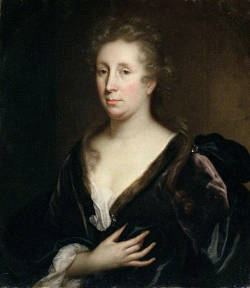
Godfried Schalcken
Before 1706
Oil on canvas, 71.8x 62.2 cm.
The Wilson (Cheltenham), Cheltenham, England
For the Dutch Golden Age, still life painting was a highly respected genre, with renowned painters such as Clara Peeters, Rachel Ruysch (1664–1750) (fig. 5), and Maria van Oosterwijck (1630–1693) being pivotal figures in this tradition. These artists' works focused on intricate depictions of flora, fauna, and symbolic objects, often conveying themes of abundance, mortality, and the passage of time (fig. 6). Rachel Ruysch, in particular, gained considerable acclaim for her skill in botanical still lifes, which have been subjects of extensive scholarship and reassessment in recent decades.
Born in 1664 to a family connected to scientific and botanical circles, Ruysch developed an expertise in painting flowers, insects, and small creatures with remarkable precision. Her work became emblematic of Dutch still life painting, and she achieved professional success and acclaim uncommon for women of her time. In recent decades, Rachel Ruysch’s still lifes have gained renewed interest, with scholars exploring themes beyond mere visual mastery. This includes her nuanced approach to color, composition, and symbolism, especially in how she portrayed decay and growth, as well as her contributions to scientific illustration. Scholars have recognized her influence within the field of natural history and the connections between her art and the burgeoning field of botany in the Dutch Republic, where scientific curiosity and empirical observation were highly valued.
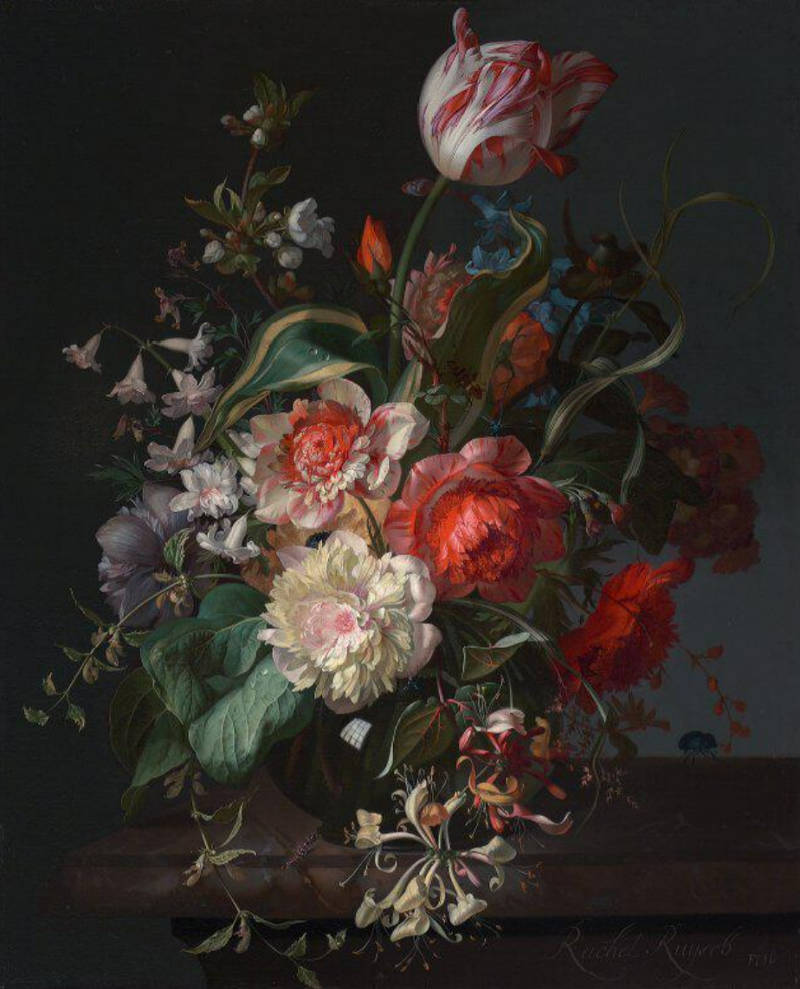
Rachel Ruysch
1716
Oil on canvas, 46.5 × 36 cm.
National Gallery, London
Born in The Hague and raised in Amsterdam, Rachael was influenced by her father, anatomist Frederik Ruysch, who taught her botany and painting. At fifteen, she studied under flower painter Willem van Aelst, also painting reptiles and insects. She married portrait painter Juriaen Pool in 1695, with whom she had ten children. In 1701, she became the first woman admitted to The Hague’s Confrérie Pictura, and later served as a court painter in Düsseldorf for Johann Wilhelm of the Palatinate.
Ruysch’s works, known for their dramatic contrasts, rich colors, and intricate botanical accuracy, were in high demand and achieved high prices (fig. xx). She won a large lottery prize in 1723, and her influence on flower painting endured for generations. Despite drawing inspiration from her father’s botanical collections, none of her preparatory sketches have survived.

Jacoba Maria van Nickelen
c. 1710-1749
Brush drawing opaque colors, all-round edging line with the brush in black, on ribbed handmade paper, 26 x 21 cm
Städel Museum, Frankfurt au Main
She was a role model for Jacoba van Nickelen (1690–1749) (fig. 7) , daughter of Jan van Nickelen. Her bouquets of flowers against a dark background appear lush. All the light is concentrated on the blossoms, while delicate grasses add accents. Sharp light-dark contrasts, subdued brown contours and the intense interplay of cold and warm colors create a strong three-dimensional effect. Even more than her predecessors and teachers, Ruysch combines a wide variety of flowers to create a rich selection. She will have benefited from her father's extensive botanical collection, who built up and catalogued the Botanical Garden in Amsterdam as one of the richest plant collections. She probably made her first sketches there. A picture of her that Michiel van Musscher painted shows such drawings. However, none of her collections of models have survived. Her career spanned over 65 years.